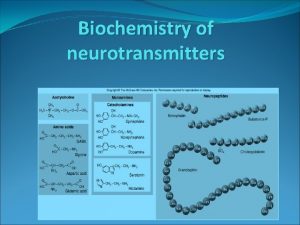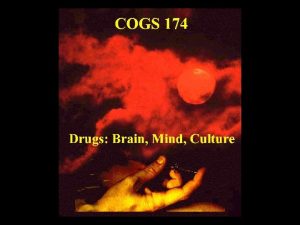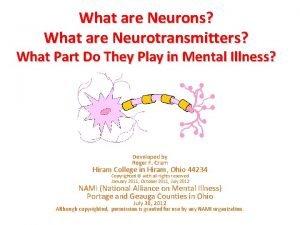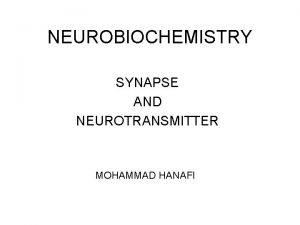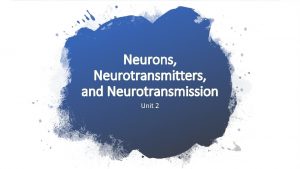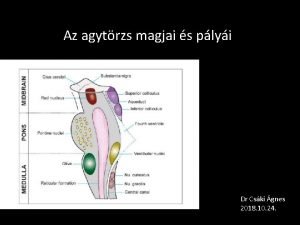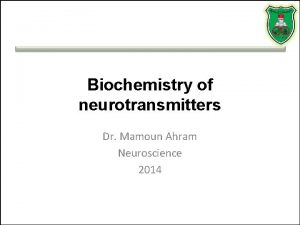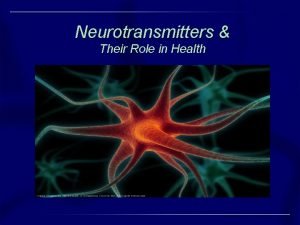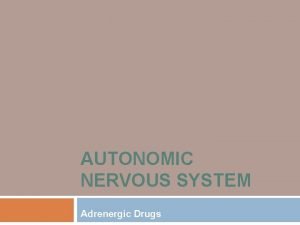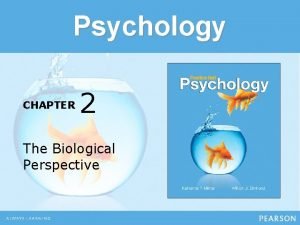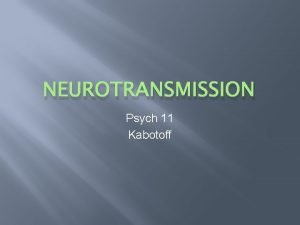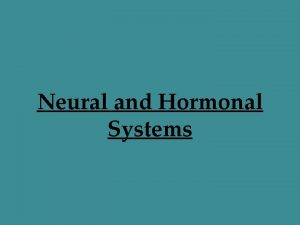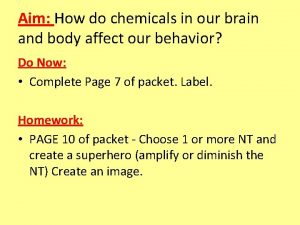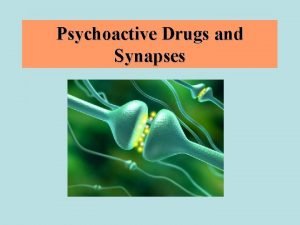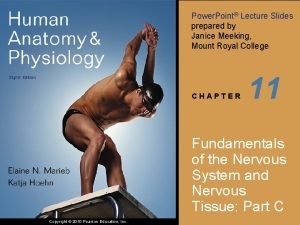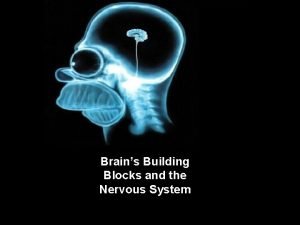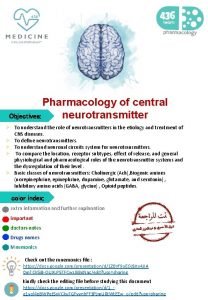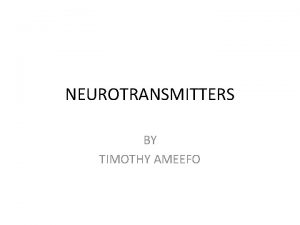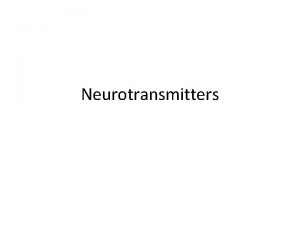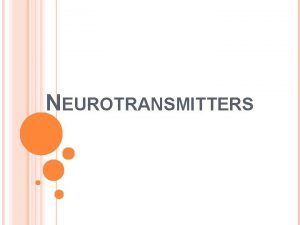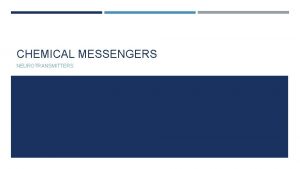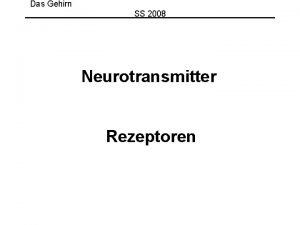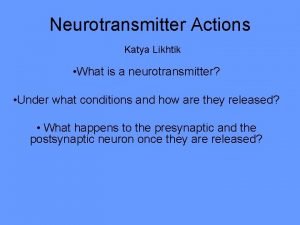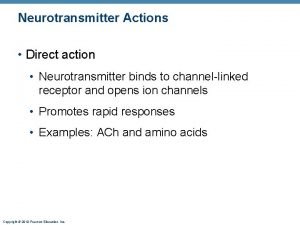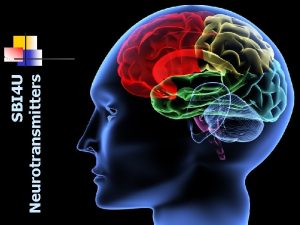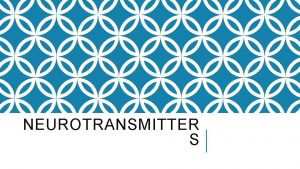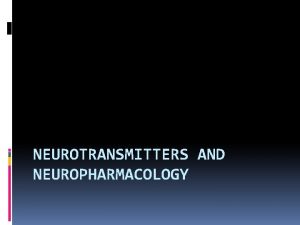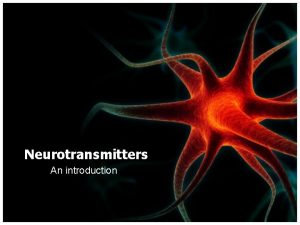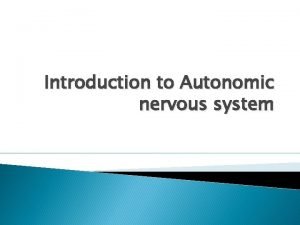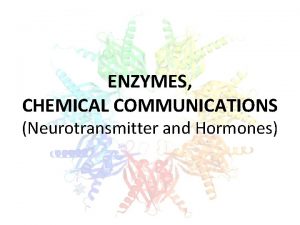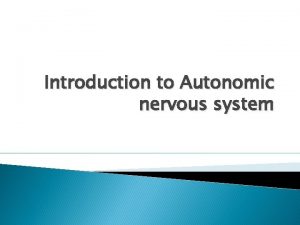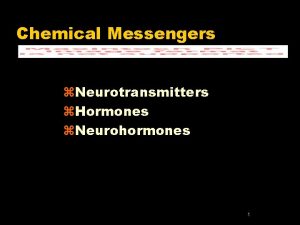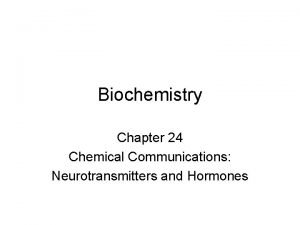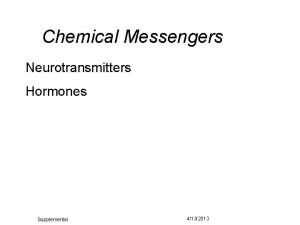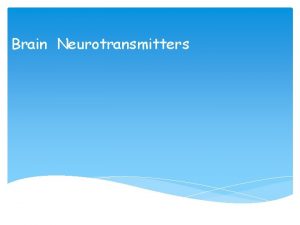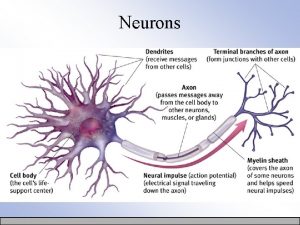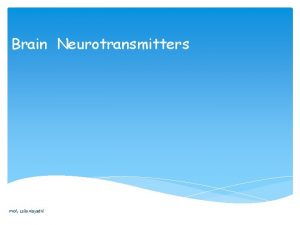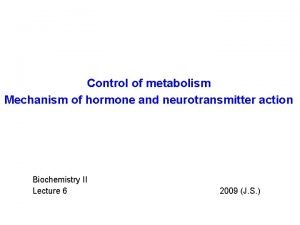18 4 Neurotransmitters A neurotransmitter is a chemical

























- Slides: 25

18. 4 Neurotransmitters A neurotransmitter is a chemical compound that transmits an impulse from a nerve cell to a target cell. Target cells may be another nerve cell, a muscle cell, or a gland cell. Learning Goal Describe the role of amines as neurotransmitters. General, Organic, and Biological Chemistry: Structures of Life, 5/e Karen C. Timberlake A nerve cell consists of a cell body and filaments called axons and dendrites that form junctions with nearby nerve cells to transmit nerve impulses. © 2016 Pearson Education, Inc.

Neurons A neuron, also known as a nerve cell, consists of • a cell body and numerous filaments called dendrites at one end. • an axon that ends at the axon terminal at the opposite end. • junctions called synapses formed between the axon terminals and dendrites of other nerve cells. Within a nerve cell, neurotransmitters are synthesized and stored in vesicles at the end of the axon terminal. General, Organic, and Biological Chemistry: Structures of Life, 5/e Karen C. Timberlake © 2016 Pearson Education, Inc.

Neurotransmitters at the Synapse When an electrical signal reaches the axon terminal of a nerve cell, • neurotransmitters are released into the synapse and taken up by the dendrites in nearby nerve cells. • electrical impulses and chemical transmitters move information through a network of nerve cells in a very short period of time. Neurotransmitters can be • excitatory, stimulating the receptors to send more impulses. • inhibitory, decreasing the activity of the receptors. The binding of an excitatory neurotransmitter opens ion channels in nearby nerve cells, releasing more neurotransmitters. General, Organic, and Biological Chemistry: Structures of Life, 5/e Karen C. Timberlake © 2016 Pearson Education, Inc.

Termination of Neurotransmitters can be removed from the receptors in different ways: 1. The neurotransmitter diffuses away from the synapse. 2. Enzymes in the receptors break down the neurotransmitter. 3. Reuptake returns the neurotransmitter to the vesicles, where it is stored. General, Organic, and Biological Chemistry: Structures of Life, 5/e Karen C. Timberlake © 2016 Pearson Education, Inc.

Amine Neurotransmitters contain nitrogen atoms as amines and alkylammonium ions; • they are synthesized from compounds such as amino acids obtained from our diets. • their amino groups are usually ionized, forming ammonium cations and carboxylate anions. Important amine neurotransmitters include acetylcholine, dopamine, norepinephrine (noradrenaline), epinephrine (adrenaline), serotonin, histamine, glutamate, and GABA. General, Organic, and Biological Chemistry: Structures of Life, 5/e Karen C. Timberlake © 2016 Pearson Education, Inc.

Acetylcholine • communicates between the nervous system and the muscle. • regulates muscle activation as well as learning and short-term memory. • is synthesized by forming an ester between choline and acetate and is stored in the vesicles. • is released into the synapse, where it binds to receptors on the muscle cells and causes the muscles to contract. General, Organic, and Biological Chemistry: Structures of Life, 5/e Karen C. Timberlake © 2016 Pearson Education, Inc.

Acetylcholine • To enable continual nerve transmission, acetylcholine is quickly degraded by enzymes that hydrolyze the ester bond. • The loss of the acetylcholine at the receptors causes muscle cells to relax. • The resulting choline and acetate are converted back to acetylcholine and stored in the vesicles. General, Organic, and Biological Chemistry: Structures of Life, 5/e Karen C. Timberlake © 2016 Pearson Education, Inc.

Acetylcholine Loss in Adults In older adults, a decrease in acetylcholine • produces gaps in short-term memory. • by 90% causes severe loss of reasoning and motor function and is known as Alzheimer’s disease. Medications that are cholinesterase inhibitors, such as Aricept, are used to slow the breakdown of acetylcholine in order to maintain the acetylcholine levels in the brain. General, Organic, and Biological Chemistry: Structures of Life, 5/e Karen C. Timberlake © 2016 Pearson Education, Inc.

Nerve Poisons Nerve poisons such as Sarin, Soman, and Parathion • bind to the acetylcholinesterase enzyme and inhibit its action. • result in a buildup of acetylcholine in the synapse, stopping nerve transmissions. Because acetylcholine cannot be released, the muscles in the body cannot relax, and convulsions and respiratory failure soon occur. General, Organic, and Biological Chemistry: Structures of Life, 5/e Karen C. Timberlake © 2016 Pearson Education, Inc.

Catecholamines The most important catecholamine neurotransmitters are • dopamine, norepinephrine, and epinephrine. • closely related in structure. • synthesized from the amino acid tyrosine found in meats, nuts, eggs, and cheese. Amphetamine and methamphetamine are synthetic central nervous system stimulants that increase excitatory catecholamine neurotransmitters, particularly dopamine and norepinephrine. General, Organic, and Biological Chemistry: Structures of Life, 5/e Karen C. Timberlake © 2016 Pearson Education, Inc.

Amphetamines Amphetamine and methamphetamine • are synthetic central nervous system stimulants. • increase excitatory catecholamine neurotransmitters, particularly dopamine and norepinephrine. Amphetamine is used in the treatment of ADHD to improve cognition and decrease hyperactivity. General, Organic, and Biological Chemistry: Structures of Life, 5/e Karen C. Timberlake © 2016 Pearson Education, Inc.

Catecholamines The neurotransmitters dopamine, norepinephrine, and epinephrine are synthesized from the amino acid tyrosine after it is converted to L-dopa. General, Organic, and Biological Chemistry: Structures of Life, 5/e Karen C. Timberlake © 2016 Pearson Education, Inc.

Dopamine, produced in the nerve cells of the midbrain, • works as a natural stimulant to give us energy and feelings of enjoyment. • plays a role in controlling muscle movement and regulation of the sleep–wake cycle and helps to improve cognition, attention, memory, and learning. Reuptake may be blocked by cocaine and amphetamines, leaving dopamine in the synapse. High levels of dopamine may contribute to addictive behavior and schizophrenia. General, Organic, and Biological Chemistry: Structures of Life, 5/e Karen C. Timberlake © 2016 Pearson Education, Inc.

L-Dopa Increases Dopamine L-Dopa is used to increase dopamine levels in the brain. Parkinson’s disease causes the midbrain nerve cells to lose their ability to produce dopamine. General, Organic, and Biological Chemistry: Structures of Life, 5/e Karen C. Timberlake © 2016 Pearson Education, Inc.

Norepinephrine and Epinephrine Norepinephrine (noradrenaline) and epinephrine (adrenaline) • are hormonal neurotransmitters. • play a role in sleep, attention and focus, and alertness. • are normally produced in the adrenal glands and are produced in large quantities when the stress of physical threat is causing the flight-or-fight response. Epinephrine is synthesized from norepinephrine by the addition of a methyl group to the amine. General, Organic, and Biological Chemistry: Structures of Life, 5/e Karen C. Timberlake © 2016 Pearson Education, Inc.

Serotonin (5 -hydroxytryptamine) • helps us to relax, sleep deeply and peacefully, and think rationally and gives us a feeling of well-being and calmness. • is synthesized from the amino acid tryptophan, which can cross the blood-brain barrier. General, Organic, and Biological Chemistry: Structures of Life, 5/e Karen C. Timberlake © 2016 Pearson Education, Inc.

Serotonin and Depression Low levels of serotonin in the brain may be associated with depression, anxiety disorders, obsessive-compulsive disorder, and eating disorders. Many antidepressant drugs, such as fluoxetine (Prozac) and paroxetine (Paxil), are selective serotonin reuptake inhibitors, SSRIs. General, Organic, and Biological Chemistry: Structures of Life, 5/e Karen C. Timberlake © 2016 Pearson Education, Inc.

Serotonin and Depression When the reuptake of serotonin is slowed by SSRIs, it remains longer at the receptors, where it continues its action; the net effect is as if additional quantities of serotonin were taken. General, Organic, and Biological Chemistry: Structures of Life, 5/e Karen C. Timberlake © 2016 Pearson Education, Inc.

Histamine is • synthesized in nerve cells in the hypothalamus from the amino acid histidine. • produced by the immune system in response to pathogens and invaders or injury. General, Organic, and Biological Chemistry: Structures of Life, 5/e Karen C. Timberlake © 2016 Pearson Education, Inc.

Histamine, Antihistamines Histamine • combines with histamine receptors to cause allergic reactions, which may include inflammation, watery eyes, itchy skin, and hay fever. • is also stored and released in the cells of the stomach, where it stimulates acid production. Antihistamines, such as Benadryl, Zantac, and Tagamet, are used to block the histamine receptors and stop the allergic reactions. General, Organic, and Biological Chemistry: Structures of Life, 5/e Karen C. Timberlake © 2016 Pearson Education, Inc.

Glutamate • is the most abundant neurotransmitter in the nervous system. • is used to stimulate over 90% of the synapses. When glutamate binds to its receptor cells, it stimulates the synthesis of nitrogen oxide (NO), also a neurotransmitter in the brain. Glutamate and NO are thought to be involved in learning and memory. General, Organic, and Biological Chemistry: Structures of Life, 5/e Karen C. Timberlake © 2016 Pearson Education, Inc.

Glutamate Levels In Lou Gehrig’s disease (ALS), production of an excessive amount of glutamate causes the degeneration of nerve cells in the spinal cord. As a result, a person with Lou Gehrig’s disease suffers increasing weakness and muscular atrophy. When the reuptake of glutamate is too rapid, the levels of glutamate fall too low in the synapse, which may result in mental illness such as schizophrenia. General, Organic, and Biological Chemistry: Structures of Life, 5/e Karen C. Timberlake © 2016 Pearson Education, Inc.

GABA Gamma(γ)-aminobutyric acid, or GABA, • is produced from glutamate and is the most common inhibitory neurotransmitter in the brain. • reduces anxiety by inhibiting the ability of nerve cells to send electrical signals to nearby nerve cells. • is involved in the regulation of muscle tone, sleep, and anxiety. GABA can be obtained as a nutritional supplement. Medications such as benzodiazepines and barbiturates such as phenobarbital are used to increase GABA levels at the GABA receptors. General, Organic, and Biological Chemistry: Structures of Life, 5/e Karen C. Timberlake © 2016 Pearson Education, Inc.

GABA from Glutamate Alcohol, sedatives, and tranquilizers increase the inhibitory effects of GABA. Caffeine decreases the GABA levels in the synapses, leading to conditions of anxiety and sleep problems. General, Organic, and Biological Chemistry: Structures of Life, 5/e Karen C. Timberlake © 2016 Pearson Education, Inc.

Summary of Neurotransmitters General, Organic, and Biological Chemistry: Structures of Life, 5/e Karen C. Timberlake © 2016 Pearson Education, Inc.
 Somatic nervous system neurotransmitters
Somatic nervous system neurotransmitters Skeletal muscle neurotransmitter
Skeletal muscle neurotransmitter Small molecule neurotransmitters
Small molecule neurotransmitters Life cycle of neurotransmitter
Life cycle of neurotransmitter Neurotransmitter
Neurotransmitter Neurotransmitter
Neurotransmitter Neurotransmitter
Neurotransmitter Inhibitory neurotransmitter
Inhibitory neurotransmitter What neurotransmitter is scarce during depression
What neurotransmitter is scarce during depression Neurotransmitter
Neurotransmitter Whats a neurotransmitter
Whats a neurotransmitter Fasciculus longitudinalis medialis
Fasciculus longitudinalis medialis Small-molecule neurotransmitters
Small-molecule neurotransmitters This neurotransmitter is __________.
This neurotransmitter is __________. Function of excitatory neurotransmitters
Function of excitatory neurotransmitters Acute bronchospasm
Acute bronchospasm Neurotransmitters and their functions
Neurotransmitters and their functions Fun facts about neurotransmitters
Fun facts about neurotransmitters Nerves are neural cables containing many
Nerves are neural cables containing many Reuptake of neurotransmitters
Reuptake of neurotransmitters Neurotransmitters and drugs
Neurotransmitters and drugs Types of neurotransmitters
Types of neurotransmitters How do neurotransmitters influence behavior
How do neurotransmitters influence behavior Vcaa psychology study design
Vcaa psychology study design Inhibitory neurotransmitters
Inhibitory neurotransmitters List of neurotransmitters
List of neurotransmitters


